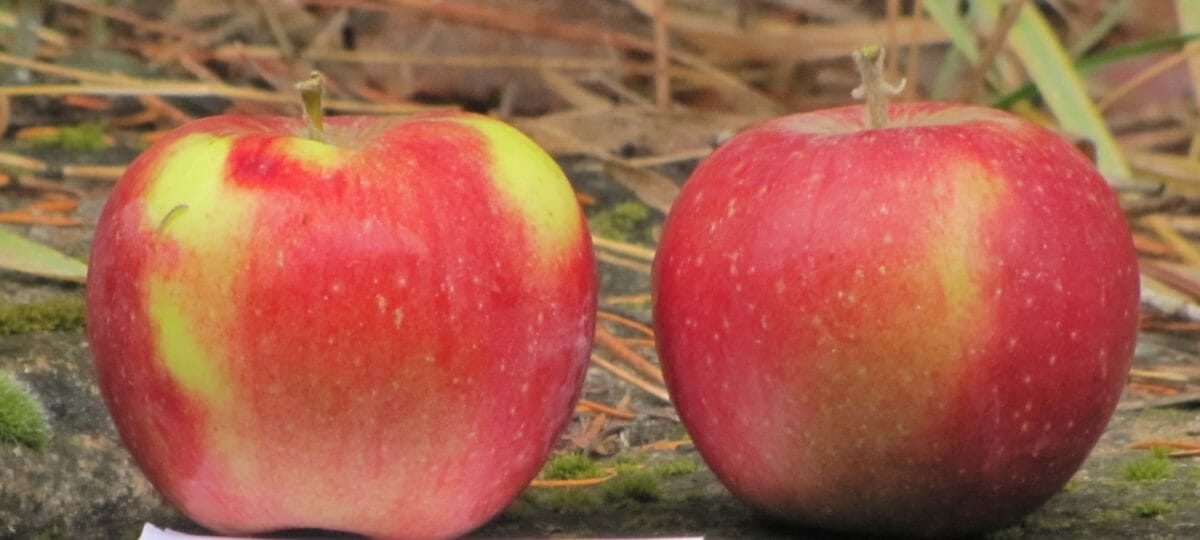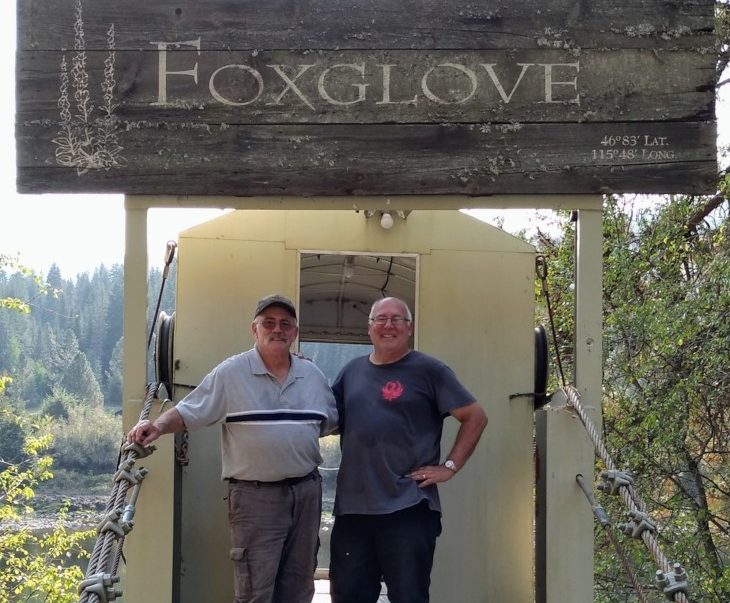Why Apple Detectives Are Tracking Down Lost Varieties
Apples offer possibilities for the future by bridging our past and present.
Why Apple Detectives Are Tracking Down Lost Varieties
Apples offer possibilities for the future by bridging our past and present.

Behold a Streaked Pippin!courtesy of the Lost Apple Project
The phrase “lost and found” is being imbued with fresh meaning thanks to the Lost Apple Project.
Since 2014, the nonprofit organization has found 23 lost or nearly extinct apple varieties. At least 17,000 named varieties were once grown here after early colonists brought apples to America; today, there are just 5,000. The group seeks to identify and preserve heritage apple trees planted before 1920 in the Pacific Northwest.
“The history these old apple trees have is just incredible,” says Dave Benscoter, a former FBI agent and IRS investigator, who runs the Lost Apple Project with EJ Brandt.
Apple hunting is painstaking and time intensive. In addition to Benscoter and Brandt scouring nursery ledgers, plat maps, county fair records and the internet for potential leads, they received 600 tips last year alone. Each fall, they send 200 sample bags of found varieties to the Temperate Orchard Conservancy in Oregon for identification. The group offers grafting classes and sells trees to cover costs.
Since Benscoter started the project, he says he’s gained a deeper understanding of how difficult life was back in the early days after apples were introduced to America. “The truth of the matter is these apples saved [the] lives of pioneers,” he says. “The apple was by far the single most important thing you could grow; it had so many uses.” Homesteaders needed summer and fall apples. “Each apple had a specific purpose,” he says. “One was really good for drying, another for canning.” Sugar was produced by cooking down really sweet apples.
There were particular varieties of apples that ripen in October, such as Ben Davis apples, that people grew because they kept best. These varieties didn’t taste good until the spring, says Benscoter, when they were the only fresh fruit people would have. Hogs or horses gobbled up rotten ones.

The project is a vivid reminder that there used to be a greater variety of lettuces, peas and the like available, says mycologist Melissa Flora, who runs Lost Apple Project’s Michigan arm, which formed earlier this year. She grows heirloom vegetables in her garden, often from seeds she’s saved or swapped. “We’ve become so reliant on grocery store chains to tell us what we need to eat. To me, that’s just crazy,” she says.
Some lost apples don’t taste good, but are important for historical reasons and because they can be used to breed other apples, says Benscoter. In 2018, the Lost Apple Project re-discovered the Excelsior, the first apple bred in the United States. Benscoter says the project has botanical and plant-breeding value because some of the apples it is finding have characteristics that are very favorable. The Goldridge, which the project found in 2019, is not susceptible to a disease called apple scab.
Ben Gutierrez, the curator of the USDA’s National Apple Collection, says that the project is exciting because we don’t fully know the potential of future finds. “Genetic diversity is part of sustainability,” he explains. The more apples that the project rediscovers, the more there is to learn about which apples might grow better in various climates and conditions.
“Each apple discovered carries a legacy, interesting genetics, and a unique story,” Gutierrez says. “Like people, every apple is unique. Each helps us tell that story a little bit better so we can understand the genetic composition and where we can go in the future.”

George Raino is an apple lover who helped the project find the Kittagaskee variety in 2017 in an orchard in Boise he’d visited since his early 20s. He calls it “one of the holy grails for lost apples.” The Cherokees grew this apple, prized for its exquisite flavor and historical significance, in eighteenth century North Carolina, before being forced from their land. Raino describes it as “not overpoweringly tart nor overpoweringly sweet, well enough balanced that the bouquet floral overtones of the particular cultivar come through. The base notes of complex tannins add substance.”
That’s enough to make one salivate. Similarly, what does Benscoter do when he finally stands at the foot of a newly found tree? “The very first thing I do is taste an apple,” he says. “I just want to know what it tastes like.”
Follow us
This work is licensed under a Creative Commons Attribution-NoDerivatives 4.0 International License.
Want to republish a Modern Farmer story?
We are happy for Modern Farmer stories to be shared, and encourage you to republish our articles for your audience. When doing so, we ask that you follow these guidelines:
Please credit us and our writers
For the author byline, please use “Author Name, Modern Farmer.” At the top of our stories, if on the web, please include this text and link: “This story was originally published by Modern Farmer.”
Please make sure to include a link back to either our home page or the article URL.
At the bottom of the story, please include the following text:
“Modern Farmer is a nonprofit initiative dedicated to raising awareness and catalyzing action at the intersection of food, agriculture, and society. Read more at <link>Modern Farmer</link>.”
Use our widget
We’d like to be able to track our stories, so we ask that if you republish our content, you do so using our widget (located on the left hand side of the article). The HTML code has a built-in tracker that tells us the data and domain where the story was published, as well as view counts.
Check the image requirements
It’s your responsibility to confirm you're licensed to republish images in our articles. Some images, such as those from commercial providers, don't allow their images to be republished without permission or payment. Copyright terms are generally listed in the image caption and attribution. You are welcome to omit our images or substitute with your own. Charts and interactive graphics follow the same rules.
Don’t change too much. Or, ask us first.
Articles must be republished in their entirety. It’s okay to change references to time (“today” to “yesterday”) or location (“Iowa City, IA” to “here”). But please keep everything else the same.
If you feel strongly that a more material edit needs to be made, get in touch with us at [email protected]. We’re happy to discuss it with the original author, but we must have prior approval for changes before publication.
Special cases
Extracts. You may run the first few lines or paragraphs of the article and then say: “Read the full article at Modern Farmer” with a link back to the original article.
Quotes. You may quote authors provided you include a link back to the article URL.
Translations. These require writer approval. To inquire about translation of a Modern Farmer article, contact us at [email protected]
Signed consent / copyright release forms. These are not required, provided you are following these guidelines.
Print. Articles can be republished in print under these same rules, with the exception that you do not need to include the links.
Tag us
When sharing the story on social media, please tag us using the following: - Twitter (@ModFarm) - Facebook (@ModernFarmerMedia) - Instagram (@modfarm)
Use our content respectfully
Modern Farmer is a nonprofit and as such we share our content for free and in good faith in order to reach new audiences. Respectfully,
No selling ads against our stories. It’s okay to put our stories on pages with ads.
Don’t republish our material wholesale, or automatically; you need to select stories to be republished individually.
You have no rights to sell, license, syndicate, or otherwise represent yourself as the authorized owner of our material to any third parties. This means that you cannot actively publish or submit our work for syndication to third party platforms or apps like Apple News or Google News. We understand that publishers cannot fully control when certain third parties automatically summarize or crawl content from publishers’ own sites.
Keep in touch
We want to hear from you if you love Modern Farmer content, have a collaboration idea, or anything else to share. As a nonprofit outlet, we work in service of our community and are always open to comments, feedback, and ideas. Contact us at [email protected].by Liz Susman Karp, Modern Farmer
December 21, 2020
Modern Farmer Weekly
Solutions Hub
Innovations, ideas and inspiration. Actionable solutions for a resilient food system.
ExploreExplore other topics
Share With Us
We want to hear from Modern Farmer readers who have thoughtful commentary, actionable solutions, or helpful ideas to share.
SubmitNecessary cookies are absolutely essential for the website to function properly. This category only includes cookies that ensures basic functionalities and security features of the website. These cookies do not store any personal information.
Any cookies that may not be particularly necessary for the website to function and are used specifically to collect user personal data via analytics, ads, other embedded contents are termed as non-necessary cookies.
Maine has a group of ‘Apple Detectives’ that have been working to identify lost apples for over 30 years. They just recently planted a ‘heritage’ orchard where they are collecting representative trees from each lost variety they have rediscovered.
This Lost Apple Project is amazing! You are all wonderful!
What an interesting story. I sure would like to read and know more about this topic. Thank you.
There are several orchards on Saltspring Island in B.C. that are growing literally hundreds of varieties of apples. Apple festival yearly. Close to Washington State. Worth exploring
Read Michael Pollan’s “The Botany of Desire”–the section on Johnny Appleseed and the progression of his apple trees (from the seeds thrown out after the distillers mashed the apples up to make alcohol from them) ahead of the pioneer waves. Since every apple seed is different, and produces a new variety, the only way to propagate desirable apple varieties is through grafting or bagging a section of a twig until it roots. In 2009 a documentary was made from this book (2 hrs long). I recommend both, but the book is such great reading–highly recommend.

How do I get word to the director of the project on the location of a tree
What a great initiative.
Now my children will believe me when I explained to them that “wild” apple trees exist and the cattle appreciate the fruit.
I absolutely love apples. One of my favorite things as a young man was to visit old abandoned orchards and sample all of the fruits especially the apples. These days i plant apple seeds to see if i can come up with something really good. Most i graft onto but leave a branch to sample the new one.
The stories behind the old apple trees are fascinating. Gleneagles Golf Course in West Vancouver (BC, Canada) has some old ‘Pewaukee‘ apples by their sixth fairway. Many people ask about these grand old trees and many are very surprised to learn these were planted in the early 1900s when a farm sat on the same site. Few could guess any farm ever existed in this community that is fully residential.
My Uncle in Willowdale, Toronto has a apple tree over 100 years old and he thinks it is a Duchess Apple tree. Great for pies, juice and sauce. Have you heard of these?